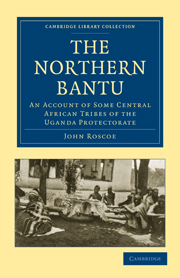Book contents
- Frontmatter
- PREFACE
- Contents
- LIST OF ILLUSTRATIONS
- Uganda and British East Africa
- PART I THE BANYORO A PASTORAL PEOPLE
- CHAP. I THE COUNTRY, THE PEOPLE, THE KING
- CHAP. II GOVERNMENT
- CHAP. III CLANS, TOTEMS AND TERMS OF RELATIONSHIP
- CHAP. IV MARRIAGE AND BIRTH
- CHAP. V SICKNESS AND DEATH
- CHAP. VI INDUSTRIES
- CHAP. VII WARFARE
- CHAP. VIII HUNTING, DRUMS AND THEIR USE
- CHAP. IX RELIGIOUS BELIEFS
- PART II THE BANYANKOLE A PASTORAL TRIBE OF ANKOLE
- PART III THE BAKENE, LAKE DWELLERS
- PART IV THE BAGESU A CANNIBAL TRIBE
- PART V THE BASOGA
- PART VI NILOTIC TRIBES. THE BATESO AND THE KAVIRONDO
- INDEX
- PUBLICATIONS OF THE CAMBRIDGE UNIVERSITY PRESS RELATING TO AFRICA
- Plate section
CHAP. I - THE COUNTRY, THE PEOPLE, THE KING
Published online by Cambridge University Press: 07 September 2011
- Frontmatter
- PREFACE
- Contents
- LIST OF ILLUSTRATIONS
- Uganda and British East Africa
- PART I THE BANYORO A PASTORAL PEOPLE
- CHAP. I THE COUNTRY, THE PEOPLE, THE KING
- CHAP. II GOVERNMENT
- CHAP. III CLANS, TOTEMS AND TERMS OF RELATIONSHIP
- CHAP. IV MARRIAGE AND BIRTH
- CHAP. V SICKNESS AND DEATH
- CHAP. VI INDUSTRIES
- CHAP. VII WARFARE
- CHAP. VIII HUNTING, DRUMS AND THEIR USE
- CHAP. IX RELIGIOUS BELIEFS
- PART II THE BANYANKOLE A PASTORAL TRIBE OF ANKOLE
- PART III THE BAKENE, LAKE DWELLERS
- PART IV THE BAGESU A CANNIBAL TRIBE
- PART V THE BASOGA
- PART VI NILOTIC TRIBES. THE BATESO AND THE KAVIRONDO
- INDEX
- PUBLICATIONS OF THE CAMBRIDGE UNIVERSITY PRESS RELATING TO AFRICA
- Plate section
Summary
Geographical position of Bunyoro. To the north-west of Uganda, ranging from a little south of the equator to the Victoria Nile on the north and between 30 and 32 degrees east of Greenwich, lies the kingdom of Bunyoro. Like Uganda, it is one of the oldest kingdoms in Central Africa and has, for many generations, been able at once to resist the inroads of adjacent tribes and also to extend its own boundaries. It is one of the few kingdoms of the Bantu tribes that possess an established monarchy with subordinate chiefs and subchiefs governing large districts. These chiefs command numerous clans, many of whom are entirely pastoral, while others, though mainly agricultural, own large flocks of goats and sheep; but all alike, both pastoral and agricultural, acknowledge the king's supremacy.
Extent of Bunyoro. The kingdom originally comprised tracts of land which now belong to Uganda proper: certainly the Budu district and also parts of the district of Bulemezi, Kyagwe, Singo and Gomba once belonged to Bunyoro, while a large district of Busoga, lying to the south-east of Bunyoro and tributary to it, was conquered by Uganda. For many years the Baganda have been slowly pushing back the Banyoro and occupying the lands thus acquired, and for some years Busoga and Budu have yielded to the superior arms of the Baganda.
- Type
- Chapter
- Information
- The Northern BantuAn Account of Some Central African Tribes of the Uganda Protectorate, pp. 3 - 17Publisher: Cambridge University PressPrint publication year: 2010First published in: 1915



